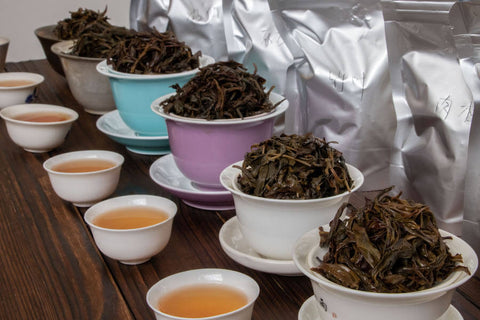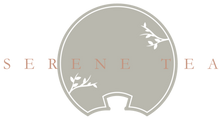What things come to your mind when you think of charcoal roasting? Do you think mostly about coffee, or pizza even? Did you know that teas that are charcoal roasted are highly prized in the tea world?
You might wonder, why would teas need to be charcoal roasted considering tea is typically pursued for its delicate flavor vs. coffee is being fond of precisely for the heavy roasting aroma.
I had the same questions, and I want to share with you what I found out!

Baked only Mi Lan Xiang vs. Charcoal Roasted Mi Lan Xiang
Charcoal Roasting vs. Baking
It was in November, 2018 that I saw a big metal wok in Farmer Xie’s tea farm. Being the current generation of the family and still an apprentice of his father, farmer Xie excitedly told me with a glimminess on his youthful face that his father used to “bake” the teas in that metal wok. The word “bake” in Chinese has a character that overlaps with “roast”, which made me confused by the difference between these two processes for a long while.
It was my first time visiting Feng Huang Shan, or the Phoenix Mountain, where Dan Cong teas are nestled. Even though I had been learning about tea's theoretical knowledge and brewing at this point, farmers could tip over what you think you know or what books teach you with what they actually do in reality. I only learned the basics about Dan Cong processing that year and it wasn’t until my visit again this year, I finally grasped the whole picture.

Charcoal roasted Dan Congs from farmer Liu 2021
When do farmers charcoal roast their Dan Congs?
Ever since the great dragon boat festival, Dan Cong tea has officially stepped into the season of charcoal roasting. This period could last from the end of June/the beginning of July to August. During this long period, farmers will observe how their teas are that year and how they have become since they were first produced in March to May. Then they will decide which teas to be charcoal roasted and the roasting sequence. Once Dan Cong teas are charcoal roasted, they need to be rested for a month before being consumed, so the roasting flavor doesn’t overpower other flavors or aroma. That’s why they are not usually available on the market until September the earliest.

The charcoal roasting equipment
How is it done?
Keep an important thing in mind, Dan Cong is an oolong tea, and usually only oolong teas can be charcoal roasted. If you remember how Dan Cong is processed, you probably know the last stage is baking the tea. This is where everything gets a bit confusing. Baking could be thought of as ‘drying’ and it can be done through a baking machine or a traditional kiln by burning wood at the bottom. Baking, however, is NOT charcoal roasting or roasting per se. Charcoal roasting is usually done in a bamboo basket that sits on top of an iron kiln with charcoal burning inside. Teas are placed in the bamboo basket, and each one has a thermal scale attached to the basket so farmers can monitor the temperature. This can only be performed by a very skillful farmer because with even the tiniest mistake, the teas will be burned. Every round of roasting takes about 8-10 hours at temperature about 90-120C, during which time, the farmer will have to patiently stand by each basket to check the temperature constantly and gently stirred the teas with their hands from time to time.
Farmers usually charcoal roast their Dan Congs once or twice, depending on how the teas are and the type. In general, there are two types, the bouquet type, such as Duck Shit, Orchid, Magnolia, Jasmine, etc., and the heavier aroma type, such as Cinnamon, Mi Lan, Tuberose, Almond, etc. Sometimes, but rather rarely, farmers will roast certain teas three times. The third time roasting is more of an add on to the previous two rounds, and if the third round is performed, it’s usually done at the very end of the year.
The benefits of charcoal roasting Dan Cong teas
The purposes or benefits of charcoal roasting Dan Cong are
- From a more technical point of view, charcoal roasting could reduce caffeine and tannin content, which result in a more smooth mouthfeel and sweet flavor.
- Charcoal roasting can keep moisture content in tea leaves under 5%. The ideal moisture content of tea leaves is between 3%-5%, going beyond or lower will cause tea leaves to oxidize and flavor change. This is why charcoal roasted teas are better for aging.
Overall, charcoal roasting tea requires not just incredible patience, but also real artisanal skills. This is why its production yield is relatively low, but real charcoal roasted Dan Cong teas are definitely more than just a fine tea!

In addition, if you have read about our white tea farmer, farmer Wen, who does charcoal roasted only white teas, you know that white teas can be charcoal roasted too. If you haven’t yet and would like to learn about it, you can also read about his farm and his charcoal roasted white teas.

1 comment
Very nice article. The best photos have been able to find of the bamboo roasters.
Would you know how the charcoal is made? I understand or have read it is made out of bamboo.
Am interested in hand processing oolong tea.
Am growing tea in North Carolina.